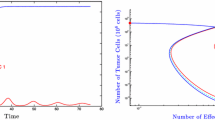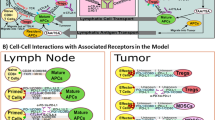Abstract
We introduce a set of ordinary differential equations (ODEs) that qualitatively reproduce delayed responses observed in immune checkpoint blockade therapy (e.g. anti-CTLA-4 ipilimumab). This type of immunotherapy has been at the forefront of novel and promising cancer treatments over the past decade and was recognised by the 2018 Nobel Prize in Medicine. Our model describes the competition between effector T cells and non-effector T cells in a tumour. By calibrating a small subset of parameters that control immune checkpoint expression along with the patient’s immune-system cancer readiness, our model is able to simulate either a complete absence of patient response to treatment, a quick anti-tumour T cell response (within days) or a delayed response (within months). Notably, the parameter space that generates a delayed response is thin and must be carefully calibrated, reflecting the observation that a small subset of patients experience such reactions to checkpoint blockade therapies. Finally, simulations predict that the anti-tumour T cell storm that breaks the delay is very short-lived compared to the length of time the cancer is able to stay suppressed. This suggests the tumour may subsist off an environment hostile to effector T cells; however, these cells are—at rare times—able to break through the tumour immunosuppressive defences to neutralise the tumour for a prolonged period. Our simulations aim to qualitatively describe the delayed response phenomenon without making precise fits to particular datasets, which are limited. It is our hope that our foundational model will stimulate further interest within the immunology modelling field.











Similar content being viewed by others
Data Availability
We reference one dataset belonging to a 2009 paper by J. D. Wolchok.
Code Availability
C. Y. Zheng used Python 3.6 from the Anaconda distribution for all simulations.
References
Alexander W (2016a) The checkpoint immunotherapy revolution. Pharm Therap 41(3):185–191
Alexander W (2016b) The checkpoint immunotherapy revolution. Pharm Therap 41(3):185–191
Antohe M, Nedelcu RI, Nichita L, Popp CG, Cioplea M, Brinzea A, Hodorogea A, Calinescu A, Balaban M, Ion DA, Diaconu C, Bleotu C, Pirici D, Zurac SA, Turcu G (2019) Tumor infiltrating lymphocytes: the regulator of melanoma evolution. Oncol Lett 17(5):4155–4161. https://doi.org/10.3892/ol.2019.9940
Ayers M, Lunceford J, Nebozhyn M, Murphy E, Loboda A, Kaufman DR, Albright A, Cheng JD, Kang SP, Shankaran V, Piha-Paul SA, Yearley J, Seiwert TY, Ribas A, McClanahan TK (2017) IFN-related mRNA profile predicts clinical response to PD-1 blockade. J Clin Invest 127(8):2930–2940. https://doi.org/10.1172/JCI91190
Balkwill FR, Capasso M, Hagemann T (2012) The tumor microenvironment at a glance. J Cell Sci 125(23):5591–5596. https://doi.org/10.1242/jcs.116392
Belz GT, Zhang L, Lay MDH, Kupresanin F, Davenport MP (2007) Killer T cells regulate antigen presentation for early expansion of memory, but not naive, CD8+ T cell. Proc Natl Acad Sci USA 104(15):6341–6346. https://doi.org/10.1073/pnas.0609990104
Buchbinder EI, Desai A (2016) CTLA-4 and PD-1 pathways: similarities, differences, and implications of their inhibition. Am J Clin Oncol 39(1):98–106. https://doi.org/10.1097/COC.0000000000000239
Callahan MK, Postow MA, Wolchok JD (2015) CTLA-4 and PD-1 pathway blockade: combinations in the clinic. Front Oncol. https://doi.org/10.3389/fonc.2014.00385
Carlson JA (2003) Tumor doubling time of cutaneous melanoma and its metastasis. Am J Dermatopathol 25(4):291–299. https://doi.org/10.1097/00000372-200308000-00003
Catron DM, Itano AA, Pape KA, Mueller DL, Jenkins MK (2004) Visualizing the first 50 Hr of the primary immune response to a soluble antigen. Immunity 21(3):341–347. https://doi.org/10.1016/j.immuni.2004.08.007
Curran MA, Allison JP (2009) Tumor vaccines expressing flt3-ligand synergize with CTLA-4 blockade to reject pre-implanted tumors. Cancer Res 69(19):7747–7755. https://doi.org/10.1158/0008-5472.CAN-08-3289
Del Monte U (2009) Does the cell number 10 \(^{\rm 9}\) still really fit one gram of tumor tissue? Cell Cycle 8(3):505–506. https://doi.org/10.4161/cc.8.3.7608
Dillekås H, Rogers MS, Straume O (2019) Are 90% of deaths from cancer caused by metastases? Cancer Med 8(12):5574–5576. https://doi.org/10.1002/cam4.2474
Dushyanthen S, Beavis PA, Savas P, Teo ZL, Zhou C, Mansour M, Darcy PK, Loi S (2015) Relevance of tumor-infiltrating lymphocytes in breast cancer. BMC Med 13(1):202. https://doi.org/10.1186/s12916-015-0431-3
Gonzalez H, Hagerling C, Werb Z (2018) Roles of the immune system in cancer: from tumor initiation to metastatic progression. Genes Dev 32(19–20):1267–1284. https://doi.org/10.1101/gad.314617.118
Grauer OM, Nierkens S, Bennink E, Toonen LW, Boon L, Wesseling P, Sutmuller RP, Adema GJ (2007) CD4+FoxP3+ regulatory T cells gradually accumulate in gliomas during tumor growth and efficiently suppress antiglioma immune responsesin vivo. Int J Cancer 121(1):95–105. https://doi.org/10.1002/ijc.22607
Hendry S, Salgado R, Gevaert T, Russell PA, John T, Thapa B, Christie M, van de Vijver K, Estrada MV, Gonzalez-Ericsson PI, Sanders M, Solomon B, Solinas C, Van den Eynden GG, Allory Y, Preusser M, Hainfellner J, Pruneri G, Vingiani A, Demaria S, Symmans F, Nuciforo P, Comerma L, Thompson EA, Lakhani S, Kim SR, Schnitt S, Colpaert C, Sotiriou C, Scherer SJ, Ignatiadis M, Badve S, Pierce RH, Viale G, Sirtaine N, Penault-Llorca F, Sugie T, Fineberg S, Paik S, Srinivasan A, Richardson A, Wang Y, Chmielik E, Brock J, Johnson DB, Balko J, Wienert S, Bossuyt V, Michiels S, Ternes N, Burchardi N, Luen SJ, Savas P, Klauschen F, Watson PH, Nelson BH, Criscitiello C, OToole S, Larsimont D, de Wind R, Curigliano G, André F, Lacroix-Triki M, van de Vijver M, Rojo F, Floris G, Bedri S, Sparano J, Rimm D, Nielsen T, Kos Z, Hewitt S, Singh B, Farshid G, Loibl S, Allison KH, Tung N, Adams S, Willard-Gallo K, Horlings HM, Gandhi L, Moreira A, Hirsch F, Dieci MV, Urbanowicz M, Brcic I, Korski K, Gaire F, Koeppen H, Lo A, Giltnane J, Ziai J, Rebelatto MC, Steele KE, Zha J, Emancipator K, Juco JW, Denkert C, Reis-Filho J, Loi S, Fox SB (2017) Assessing tumor infiltrating lymphocytes in solid tumors: a practical review for pathologists and proposal for a standardized method from the International Immuno-Oncology Biomarkers Working Group. Adv Anat Pathol 24(6):311–335. https://doi.org/10.1097/PAP.0000000000000161
Hornyák L, Dobos N, Koncz G, Karányi Z, Páll D, Szabó Z, Halmos G, Székvölgyi L (2018) The role of indoleamine-2,3-dioxygenase in cancer development, diagnostics, and therapy. Front Immunol. https://doi.org/10.3389/fimmu.2018.00151
Hunter KA, Socinski MA, Villaruz LC (2018) PD-L1 testing in guiding patient selection for PD-1/PD-L1 inhibitor therapy in lung cancer. Mol Diagn Ther 22(1):1–10. https://doi.org/10.1007/s40291-017-0308-6
Hwang S, Kwon AY, Jeong JY, Kim S, Kang H, Park J, Kim JH, Han OJ, Lim SM, An HJ (2020) Immune gene signatures for predicting durable clinical benefit of anti-PD-1 immunotherapy in patients with non-small cell lung cancer. Sci Rep 10(1):643. https://doi.org/10.1038/s41598-019-57218-9
Khair DO, Bax HJ, Mele S, Crescioli S, Pellizzari G, Khiabany A, Nakamura M, Harris RJ, French E, Hoffmann RM, Williams IP, Cheung A, Thair B, Beales CT, Touizer E, Signell AW, Tasnova NL, Spicer JF, Josephs DH, Geh JL, MacKenzie Ross A, Healy C, Papa S, Lacy KE, Karagiannis SN (2019) Combining immune checkpoint inhibitors: established and emerging targets and strategies to improve outcomes in melanoma. Front Immunol. https://doi.org/10.3389/fimmu.2019.00453
Marzolini MAV, Quezada SA, Peggs KS (2015) Checkpoint blockade in cancer immunotherapy: squaring the circle. EMG Oncol 3(1):70–76
Medema JP, de Jong J, Peltenburg LTC, Verdegaal EME, Gorter A, Bres SA, Franken KLMC, Hahne M, Albar JP, Melief CJM, Offringa R (2001) Blockade of the granzyme B/perforin pathway through overexpression of the serine protease inhibitor PI-9/SPI-6 constitutes a mechanism for immune escape by tumors. Proc Natl Acad Sci 98(20):11515–11520. https://doi.org/10.1073/pnas.201398198
Narod S (2012) Disappearing breast cancers. Curr Oncol 19(2):59–60. https://doi.org/10.3747/co.19.1037
Nurieva R, Wang J, Sahoo A (2013) T-cell tolerance in cancer. Immunotherapy 5(5):513–531. https://doi.org/10.2217/imt.13.33
Oleinika K, Nibbs RJ, Graham GJ, Fraser AR (2013) Suppression, subversion and escape: the role of regulatory T cells in cancer progression. Clin Exp Immunol 171(1):36–45. https://doi.org/10.1111/j.1365-2249.2012.04657.x
Paijens ST, Vledder A, de Bruyn M, Nijman HW (2021) Tumor-infiltrating lymphocytes in the immunotherapy era. Cell Mol Immunol 18(4):842–859. https://doi.org/10.1038/s41423-020-00565-9
Palucka K, Banchereau J (2012) Cancer immunotherapy via dendritic cells. Nat Rev Cancer 12(4):265–277. https://doi.org/10.1038/nrc3258
Pardoll DM (2012) The blockade of immune checkpoints in cancer immunotherapy. Nat Rev Cancer 12(4):252–264. https://doi.org/10.1038/nrc3239
Postow MA, Callahan MK, Wolchok JD (2015) Immune checkpoint blockade in cancer therapy. J Clin Oncol 33(17):1974–1982. https://doi.org/10.1200/JCO.2014.59.4358
Quezada SA, Peggs KS, Curran MA, Allison JP (2006) CTLA4 blockade and GM-CSF combination immunotherapy alters the intratumor balance of effector and regulatory T cells. J Clin Investig 116(7):1935–1945. https://doi.org/10.1172/JCI27745
Renner A, Burotto M, Rojas C (2019) Immune checkpoint inhibitor dosing: can we go lower without compromising clinical efficacy? J Glob Oncol. https://doi.org/10.1200/JGO.19.00142
Rotte A (2019) Combination of CTLA-4 and PD-1 blockers for treatment of cancer. J Exp Clin Cancer Res 38(1):255. https://doi.org/10.1186/s13046-019-1259-z
Rowshanravan B, Halliday N, Sansom DM (2018) CTLA-4: a moving target in immunotherapy. Blood 131(1):58–67. https://doi.org/10.1182/blood-2017-06-741033
Seidel JA, Otsuka A, Kabashima K (2018) Anti-PD-1 and Anti-CTLA-4 therapies in cancer: mechanisms of action, efficacy, and limitations. Front Oncol. https://doi.org/10.3389/fonc.2018.00086
Sims GP, Rowe DC, Rietdijk ST, Herbst R, Coyle AJ (2010) HMGB1 and RAGE in inflammation and cancer. Annu Rev Immunol 28(1):367–388. https://doi.org/10.1146/annurev.immunol.021908.132603
Sliwkowski MX, Mellman I (2013) Antibody therapeutics in cancer. Science 341(6151):1192–1198. https://doi.org/10.1126/science.1241145
Swann JB, Smyth MJ (2007) Immune surveillance of tumors. J Clin Investig 117(5):1137–1146. https://doi.org/10.1172/JCI31405
Tang D, Kang R, Zeh HJ III, Lotze MT (2010) High-mobility group box 1 and cancer. Biochimica et Biophysica Acta BBA Gene Regul Mech 1799(1–2):131–140. https://doi.org/10.1016/j.bbagrm.2009.11.014
Tang F, Du X, Liu M, Zheng P, Liu Y (2018) Anti-CTLA-4 antibodies in cancer immunotherapy: selective depletion of intratumoral regulatory T cells or checkpoint blockade? Cell Biosci. https://doi.org/10.1186/s13578-018-0229-z
Tesi RJ (2019) MDSC; the most important cell you have never heard of. Trends Pharmacol Sci 40(1):4–7. https://doi.org/10.1016/j.tips.2018.10.008
Topalian SL, Weiner GJ, Pardoll DM (2011) Cancer immunotherapy comes of age. J Clin Oncol 29(36):4828–4836. https://doi.org/10.1200/JCO.2011.38.0899
Waldman AD, Fritz JM, Lenardo MJ (2020) A guide to cancer immunotherapy: from T cell basic science to clinical practice. Nat Rev Immunol 20(11):651–668. https://doi.org/10.1038/s41577-020-0306-5
Wolchok JD, Hoos A, ODay S, Weber JS, Hamid O, Lebbe C, Maio M, Binder M, Bohnsack O, Nichol G, Humphrey R, Hodi FS (2009) Guidelines for the evaluation of immune therapy activity in solid tumors: immune-related response criteria. Clin Cancer Res 15(23):7412–7420. https://doi.org/10.1158/1078-0432.CCR-09-1624
Yi M, Jiao D, Qin S, Chu Q, Wu K, Li A (2019) Synergistic effect of immune checkpoint blockade and anti-angiogenesis in cancer treatment. Mol Cancer 18(1):60. https://doi.org/10.1186/s12943-019-0974-6
Acknowledgements
This scientific work was supported by the Australian Postgraduate Award (CYZ) and the Australian Research Council Discovery Project DP180101512 (PSK). We thank Peter P. Lee (Beckman Research Institute, City of Hope, California, USA) for his guidance and insights on immune checkpoint blockades.
Funding
This scientific work was supported by the Australian Postgraduate Award (CYZ) and the Australian Research Council Discovery Project DP180101512 (PSK).
Author information
Authors and Affiliations
Contributions
PSK is CYZ’s PhD supervisor. We also thank Peter P. Lee (Beckman Research Institute, City of Hope, California, USA) for his guidance and insights on immune checkpoint blockades.
Corresponding author
Ethics declarations
Conflict of interest
The authors declare that they have no conflict of interest.
Additional information
Publisher's Note
Springer Nature remains neutral with regard to jurisdictional claims in published maps and institutional affiliations.
Rights and permissions
About this article
Cite this article
Zheng, C.Y., Kim, P.S. Mathematical Model for Delayed Responses in Immune Checkpoint Blockades. Bull Math Biol 83, 106 (2021). https://doi.org/10.1007/s11538-021-00933-0
Received:
Accepted:
Published:
DOI: https://doi.org/10.1007/s11538-021-00933-0




